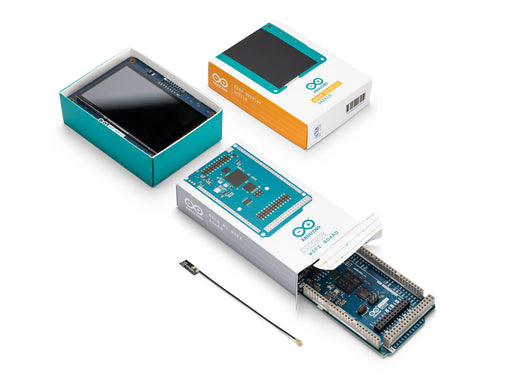
HM0360 VGA Monochrome DVP Camera Module for Arduino GIGA R1 WiFi Board
Low light sensitive, ultralow power consumption, simple interface, compatibility with Arduino libraries, suitable for battery-powered and energy-efficient applications.
Overview
The camera module is based on HM0360 VGA image sensor, which is an ultralow power, Back Side Illuminated (BSI) CMOS sensor designed for energy efficient smart vision applications, such as object-specific classification, tracking, and identification. The VGA resolution is ideal for monitoring, detection and image capture for wide field of view camera devices.
The low consumption camera module is equipped with a 64°(DFOV) stock Lens. It supports 8-bit RAW output format. The standrad operating temperature is between -30~85℃, with the stable Image temp. between 0~50℃.
It is fully compatible with Arduino GIGA R1 WiFi board, a professional-grade microcontroller development board recently launched by Arduino. Seamlessly integrates with our camera module, unlocking versatile image capture and processing capabilities. Harness the power of Arduino GIGA R1 WiFi and gain a competitive edge in your projects.
Features:
- Cost-Effective: Affordable solution for implementing visual capabilities in cost-sensitive projects.
- Compact Size: Compact form factor enables integration into space-constrained applications.
- Simplify Embedded Vision for All: Easy to set up and operate. Making it possible to add machine vision to your GIGA R1 WiFi board without much effort at all.
- High Precision: With on chip high precision oscillator, Bad Pixel correction(BPC), auto exposure/gain, amblent light sensor and zone detection
- Low Power Consumption: Efficient power usage, making it suitable for battery-powered and energy-efficient applications.
Tech specs
| Image Sensor | HM0360 |
| Resolution | VGA |
| Optical Size | 1/6'' |
| Number of effective pixels | 640(H) × 480(V) |
| Pixel Size | 3.6μm × 3.6μm |
| Support Platform | Arduino GIGA R1 WiFi Board |
| Shutter Type | Electronic Rolling Shutter |
| Color Filter Array | Monochrome |
| Frame Rate | 640x480@15fps, 320x240/160x120@30fps |
| Output Format | RAW8/RAW4 |
| F.NO | 2.8±5% |
| Focus Type | Fixed Focus |
| Focal Length | 2.59mm |
| Field of View(FOV) | 64°(D) |
| Power Supply | AVDD: 2.8V; DOVDD: 1.8V; DVDD: 1.2V |
| Operating Temperature | -30~85℃ |
| Camera Board Size | 30.5mm x 30.5mm |
Documentation
Get Inspired

A fully-operational and field-tested photovoltaic plant that automatically sets the optimal angles based on time and location.

Mark your calendars: May 23rd-25th we’ll be at SPS Italia, one of the country’s leading fairs for smart, digital, sustainable industry and a great place to find out what’s new in automation worldwide. We expect a lot of buzz around AI for IoT applications – and, of course, we’ll come prepared to give our own, open-source perspective on the AIoT trend. At Arduino Pro’s booth C012, pavilion 7, our experts will be presenting some of the latest additions to our ever-growing ecosystem, which includes everything companies need to fully embrace digital transformation with professional performance paired with Arduino’s ease of use and open-source philosophy. You can explore our complete digital brochure here, but let us point out some recent highlights. Meet the Arduino Pro ecosystem at SPS Italia 2023 Over the years, Arduino Pro has built quite the presence on the market with SOMs like the Portenta H7 and X8, recently joined by the Portenta C33: a cost-effective, high-performance option that makes automation accessible to more users than ever, based on the RA6M5, an Arm® Cortex®-M33 microcontroller from Renesas.Our Nicla family of ultra-compact boards also expanded: after Nicla Sense ME and Nicla Vision, Nicla Voice packs all the sensors, intelligence and connectivity you need for speech recognition on the edge, leveraging AI and ML. What’s more, the Arduino ecosystem also includes turnkey solutions like the Portenta Machine Control and the new Opta, our very first microPLC, designed in partnership with Finder to support the Arduino programming experience with the main PLC standard languages – and available in 3 variants with different connectivity features: Opta Lite, Opta RS485, and Opta WiFi. Both the Portenta Machine Control and Opta can be programmed via the new PLC IDE, designed to help you boost production and build automation with your own Industry 4.0 control system. Finally, since SPS Italy’s last edition we have










